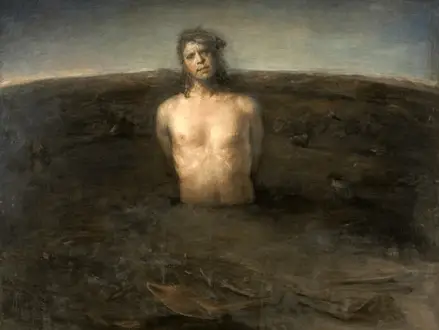Title of Artwork: “Second Birth”

Artwork by Odd Nerdrum
Year Created 2004
Summary of Second Birth
Odd Nerdrum’s work includes numerous self-portraits. Second Birth (2004) is a statement piece in which Nerdrum takes a risky stance by depicting himself as a prophet or Messiah figure. In Judaeo-Christian belief systems, prophets play a significant role as messengers of God’s message to humanity.
Prophets are held to a higher standard because of their proximity to God, but they also carry a heavier load than other religious leaders because of the misconceptions people have about them.
All About Second Birth
Because of the nature of their work, they are frequently mocked and even persecuted for speaking the unpopular but necessary facts. Nerdrum makes a statement about the position of the artist by painting himself in the style of a prophet. Artists, like prophets, have the ability to impart spiritual truths to their listeners or viewers through their work.
Nerdrum expanded upon the Western canon of self-portraiture, most notably that of Rembrandt, whom he admired greatly. In his 1998 self-portrait titled “Frontal Self Portrait,” Nerdrum portrays himself as the resurrected Rembrandt. Making allusions to Rembrandt’s Self Portrait at the Age of 63 (1669) and Self Portrait as the Apostle Paul (1632), he fashioned himself after the Dutch master (1661).
Nerdrum revealed his own sense of self through his art; he considers himself a modern-day master of the medium. It is typical for Nerdrum to make sweeping generalisations like this. Another of his self-portraits, The Savior of Painting (1997), shows him standing barefoot in a golden gown while holding a paintbrush and palette.
Once again, the period clothing calls to mind the works of European masters. Nerdrum, who is devoted to the canons of European painting, proclaims himself in the title to be the saviour of art.
The artist goes even further with this idea in Second Birth, in which he is shown rising from the ground and, as the title suggests, being reborn.
The artist wears a crown of thorns, just like Jesus did on the cross, in a blatant allusion to the resuscitation of Christ. Just as Christ was born again from the dead, so too is the artist reborn through adversity.
Nerdrum’s focus in Second Birth was not on physical pain, but on emotional and spiritual anguish. Early works by Nerdrum, such as Hepatitis, are distinguished by their realism in depicting bodily pain (1996-1997). In the image, a twisted man appears to be taking a deep breath as he musters the will to stand up.
Second Birth depicts a very different scene, with the artist lazily lying in the dirt with his arms shackled in the ground and an expressionless face. Nerdrum’s soul is reborn; this time around, it’s an emotional and spiritual rebirth, not a physical one. The planet itself plays a significant role in Second Birth as well.
The ground serves as both a crime scene and a weapon in his painting Buried Alive (1995-1996). Another way of looking at Earth in Second Birth is as a symbol of emotional or mental distress. The artist, however, is reborn from the ashes of his trauma and rises from the ground.
Information Citations:
En.wikipedia.org, https://en.wikipedia.org/.
























